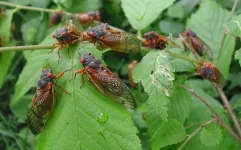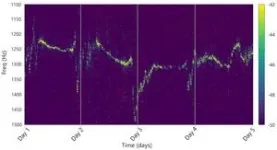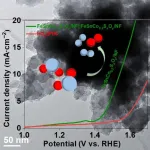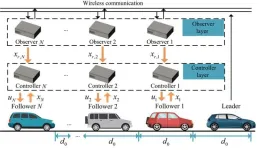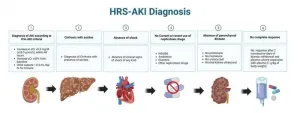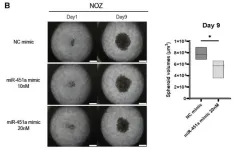However, as NEC Labs America photonics researcher Sarper Ozharar, Ph.D., explains, acoustic sensing in fiber optic cables "is limited to only nearby sound sources or very loud events, such as emergency vehicles, car alarms, or cicada emergences."
Cicadas? Indeed, periodical cicadas—the insects known for emerging by the billions on 13- or 17-year cycles and making a collective racket with their buzzy mating calls—are loud enough to be detected through fiber optic acoustic sensing. And a new proof-of-concept study shows how the technology could open new pathways for charting the populations of these famously ephemeral bugs.
"I was surprised and excited to learn how much information about the calls was gathered, despite it being located near a busy section of Middlesex County in New Jersey," says entomologist Jessica Ware, Ph.D., associate curator and chair of the Division of Invertebrate Zoology at the American Museum of Natural History and co-author on the study, published in the Entomological Society of America's Journal of Insect Science.
As the researchers explain in their report, distributed fiber optic sensing is based on detecting and analyzing "backscatter" in a cable. When an optical pulse is sent through a fiber cable, tiny imperfections or disturbances in the cable cause a small fraction of the signal to bounce back to the source. Timing the arrival of the backscattered light can be used to calculate the exact point along the cable from which it bounced back. And, monitoring how the backscatter varies over time creates a signature of the disturbance—which, in the case of acoustic sensing, can indicate volume and frequency of the sound.
A single sensor can be deployed on a huge segment of cable, too; the researchers offer an example of a 50-kilometer cable with a sensor that can detect the location of disturbances at a scale as precise as 1 meter. "This is identical to installing 50,000 [acoustic] sensors in the monitored region that are inherently synchronized and do not require onsite power supply," they write.
In 2021, Brood X, the largest of several populations of cicadas that emerge on 17-year cycles, came out of the ground in at least 15 states and the District of Columbia in the Midwest and mid-Atlantic regions of the U.S., including New Jersey, where Ozharar works at NEC Laboratories America, Inc. There, Ozharar and colleagues used NEC's fiber-sensing test apparatus—cable strung on three 35-foot utility poles on the grounds of NEC's lab in Princeton—to see if they could detect and analyze the sound of Brood X cicadas buzzing in trees nearby between June 9 and June 24 that year.
Sure enough, the cicadas' buzzing was evident. It showed up as a strong signal at 1.33 kilohertz (kHz) via the fiber optic sensing, which matched the frequency of the cicadas' call measured with a traditional audio sensor placed in same location. The researchers also observed the cicadas' peak frequency varying between 1.2 kHz and 1.5 kHz, a pattern that appeared to follow changes in temperature at the test site. The overall intensity of the cicadas' buzzing was also observed through the fiber optic sensing, and the signal decreased over the course of the test period, as the cicadas' chorus peaked and then faded as they reached the end of their reproductive period.
"We think it is really exciting and interesting that this new technology, designed and optimized for other applications and seemingly unrelated to entomology, can support entomological studies," Ozharar says. Indeed, fiber optic sensors are multifunctional, meaning they can be installed and used for any number of purposes, detecting cicadas one day and some other disturbance the next.
Ware says fiber optic sensing could soon play a role in detecting a variety of insects. "Periodical cicadas were a noisy cohort that was picked up by these systems, but it will be interesting to see if annual measurements of insect soundscapes and vibrations could be useful in monitoring insect abundance in an area across seasons and years," she says.
As for periodical cicadas, more than a dozen broods are known to emerge in different years and different areas of the eastern United States. The growing network of fiber optic infrastructure in the country—with fiber internet available to more than 40 percent of U.S. households as of 2022, according to the Fiber Broadband Association—could be incorporated into entomologists' efforts to observe and measure these emergences over time.
"Thanks to the booming development of broadband access and telecommunications, fiber cables are ubiquitously available across communities, weaving a vast network that not only provides high-speed internet but also serves as a foundation for the next generation of sensing technologies," Ozharar says.
Brood X cicadas will remain underground until 2038. Their brief appearances and massive numbers make them a challenge to study, but the long gap between their arrivals allows entomologists to make significant technological leaps in the interim. In 2021, Brood X was observed in unprecedented volume through a crowdsourced mobile smartphone app—a method barely conceivable when Brood X had last emerged in 2004. By 2038, fiber optic sensing could well be the next avenue leading to a similar advance.
###
"Long-term monitoring and analysis of Brood X cicada activity by distributed fiber-optic sensing technology" will be published online on November 30 in the Journal of Insect Science. Journalists may request advance copies of the article via the contact below or download the published paper after 10 a.m. November 30 at https://doi.org/10.1093/jisesa/iead090.
CONTACT: Joe Rominiecki, jrominiecki@entsoc.org, 301-731-4535 x3009
ABOUT: ESA is the largest organization in the world serving the professional and scientific needs of entomologists and people in related disciplines. Founded in 1889, ESA today has more than 7,000 members affiliated with educational institutions, health agencies, private industry, and government. Headquartered in Annapolis, Maryland, the Society stands ready as a non-partisan scientific and educational resource for all insect-related topics. For more information, visit www.entsoc.org.
The Journal of Insect Science publishes research on all aspects of the biology of insects and other arthropods from the molecular to the ecological, and their agricultural and medical impact. For more information, visit https://academic.oup.com/jinsectscience, or visit www.insectscience.org to view the full portfolio of ESA journals and publications.
END
